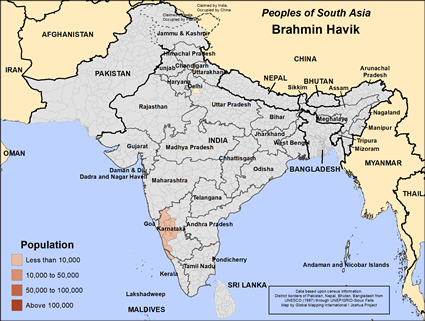Brahmin Havik in India

Send Joshua Project a photo
of this people group. |

Map Source:
People Group data: Omid. Map geography: UNESCO / GMI. Map Design: Joshua Project
|
| People Name: | Brahmin Havik |
| Country: | India |
| 10/40 Window: | Yes |
| Population: | 26,000 |
| World Population: | 26,000 |
| Primary Language: | Kannada |
| Primary Religion: | Hinduism |
| Christian Adherents: | 0.00 % |
| Evangelicals: | 0.00 % |
| Scripture: | Complete Bible |
| Ministry Resources: | Yes |
| Jesus Film: | Yes |
| Audio Recordings: | Yes |
| People Cluster: | South Asia Forward Caste - Brahmin |
| Affinity Bloc: | South Asian Peoples |
| Progress Level: |
|
Introduction / History
There are several subgroups of the Brahmins, one of which are the Haviks. The history of the Brahmins is associated with the Vedic religion of early India, usually referred to as Sanatana Dharma. Brahminism was first developed in the Vedic period, but how the modern caste system developed is a highly contested topic due to lack of clear data. Brahmins and kings became the dominant social and religious forces in many of the kingdoms that developed over pre-modern India. Discrimination became a feature of the caste system with Brahmins often being assigned blame for the system itself. Over time, Brahmins became a powerful and influential group in India and many discriminated against lower castes. Discerning opinions and heart attitudes is difficult, but it seems that only a small minority of today's Brahmins would uphold what was once considered Brahmin orthodoxy:that Brahmins are better by birth than all other peoples.
What Are Their Lives Like?
Brahmins are generally among the well-to-do in India and place a high value on education. Thus, an inordinate percentage of Brahmins are among the Hindus who have migrated to the West where they can be reached much more easily than in India. Probably most still perform daily worship rituals, but the growing forces of secularization and globalization in India are strongest among the Brahmins. Most are vegetarian but some groups eat some meat, particularly fish, and many individuals even from vegetarian Brahmin groups are now eating meat (rarely beef, and often meat eating is done in secret). Many Havik Brahmins grow areca nuts for a living. They are usually landowners. Some of them still perform priestly duties. Women help with agriculture.
What Are Their Beliefs?
Most modern Brahmins do not espouse a doctrine of their superiority by birth above other peoples. It was also noted that many are now secularists. But most Brahmins respect the ancient (and many not-so-ancient) traditions of their forefathers. Some work to synthesize modern science and Hindu beliefs and practices. There are hundreds of "denominations" of Hinduism and Brahmins have a presence in many; so it is not easy to generalize on what Brahmins believe. Some would be devotees of Vishnu or his avatars of Krishna or Ram, some would be devotees of Shiva, and some would be devotees of a goddess. Others are followers of modern gurus. Few today have seriously studied, let alone memorized, the ancient Vedas; but one is more likely to find a person knowledgeable about the Vedas and other Hindu texts and teachings among Brahmins than among any non-Brahmin caste group.
What Are Their Needs?
Like other people groups, the Havik Brahmins need to find the blessings that they can only obtain by sitting at the feet of Jesus Christ, the King of kings and Lord of lords.
Prayer Points
Brahmins are seen as knowledgeable and enlightened; pray for the light of the gospel to bring the knowledge of Christ to them, and pray wisdom for disciples of Jesus who befriend and share faith with Brahmins. Pray that the true God will reveal Himself to this community and use Brahmins to preach and teach about Jesus Christ. Pray for a disciple making movement among the Havik Brahmins.